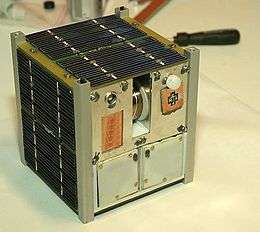AESP-14
 An 1U cubesat similar to the AESP-14 satellite. | |
| Mission type | Ionospheric research |
|---|---|
| Operator | Technology Institute of Aeronautics (ITA) |
| Website | http://www.aer.ita.br/~aesp14/ |
| Spacecraft properties | |
| Manufacturer | ITA |
| Launch mass | 5 kilograms (11 lb) |
| Dimensions |
30 cm × 10 cm × 10 cm (11.8 in × 3.9 in × 3.9 in) |
| Start of mission | |
| Launch date | 10 January 2015, 09:47:10 UTC |
| Rocket | Falcon 9 v1.1 |
| Launch site | Cape Canaveral SLC-40 |
| Contractor | SpaceX |
| Deployed from | Japanese Experiment Module (JEM) Small Satellite Orbital Deployer |
| Deployment date | 5 February 2015 |
| Entered service | 5 February 2015, 12:50 UTC |
| End of mission | |
| Decay date | 11 May 2015 |
AESP-14 is a Brazilian 1U Cubesat developed by multiple Brazilian institutions. It was launched on 10 January 2015 aboard the SpaceX CRS-5 mission on a Falcon 9 v1.1 rocket. It was the first Brazilian Cubesat ever launched into space.[1]
On 5 February, the satellite was deployed from the International Space Station using the Japanese Experiment Module (JEM) Small Satellite Orbital Deployer,[2] but an unknown malfunction caused it to be unable to transmit any data back to Earth. The satellite reentered the atmosphere on 11 May 2015.[3]
Launch
.jpg)
Launch of the Falcon 9 rocket carrying CRS-5
The launch of the CRS-5 mission, as well as AESP-14, was postponed three times from 16 December 2014 to 10 January 2015.[4] The launch successfully occurred on 10 January 2015.[5]
See also
References
- ↑ "AESP-14 CubeSat released from International Space Station". Spaceflight 101. 5 February 2015. Retrieved 19 May 2015.
- ↑ "Brazilian AESP-14 CubeSat was deployed from Kibo". JAXA. 5 February 2015. Retrieved 19 May 2015.
- ↑ "Re-Entry May 2015 - AESP-14". Spaceflight 101. Retrieved 17 September 2015.
- ↑ Heiney, Anna (7 January 2015). "Next SpaceX Launch Attempt Saturday, Jan. 10". NASA. Retrieved 19 May 2015.
- ↑ Graham, William (10 January 2015). "CRS-5 Dragon successfully launched – Core ASDS landing attempted". NASA Spaceflight. Retrieved 15 January 2015.
External links
This article is issued from Wikipedia - version of the 1/2/2016. The text is available under the Creative Commons Attribution/Share Alike but additional terms may apply for the media files.